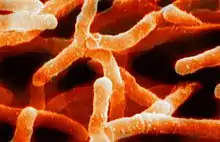Actinomyces israelii
Actinomyces israelii is a species of Gram-positive, rod-shaped bacteria within the Actinomyces. Known to live commensally on and within humans, A. israelii is an opportunistic pathogen and a cause of actinomycosis. Many physiologically diverse strains of the species are known to exist, though not all are strict anaerobes.[1] It was named after the German surgeon James Adolf Israel (1848–1926), who studied the organism for the first time in 1878.[2]
| Actinomyces israelii | |
|---|---|
 | |
| Scanning electron micrograph of Actinomyces israelii. | |
| Scientific classification | |
| Domain: | |
| Phylum: | |
| Order: | |
| Family: | |
| Genus: | |
| Species: | A. israelii |
| Binomial name | |
| Actinomyces israelii (Kruse 1896) Lachner-Sandoval 1898 | |
Pathogenesis
Actinomycosis is most frequently caused by A. israelii.[3] It is a normal colonizer of the vagina,[4] colon, and mouth.[5] Infection is established first by a breach of the mucosal barrier during various procedures (dental, gastrointestinal), aspiration, or pathologies such as diverticulitis.[6] The chronic phase of this disease is also known as the "classic phase" because the acute, early phase is often missed by health care providers. This is characterized by slow, contiguous growth that ignores tissue planes and forms a sinus tract that can spontaneously heal and recur, leading to a densely fibrotic lesion. This lesion is often characterized as "wooden."[7] Sulfur granules form in a central purulence surrounded by neutrophils. This conglomeration of organisms is virtually diagnostic of A. israelii.[8]
Treatment:
Actinomyces israelii is curable and can be treated with antibiotics. It has been shown that both a sodium hypochlorite solution and calcium hydroxide to be highly effective in killing A. israelii when it has caused infection in the mouth.[9]
References
- Levinson, W. Review of Medical Microbiology and Immunology. 2010:McGraw Hill.
- Olender, Alina (2013). "The cause of Actinomyces canalictulis". Annals of Agricultural and Environmental Medicine. 20: 742–744.
- Wade, William G.; Könönen, Eija (2015-04-01). "Actinomyces and Related Organisms in Human Infections". Clinical Microbiology Reviews. 28 (2): 419–442. doi:10.1128/CMR.00100-14. ISSN 0893-8512. PMC 4402957. PMID 25788515.
- Hoffman, Barbara (2012). Williams gynecology, 2nd edition. New York: McGraw-Hill Medical. p. 65. ISBN 978-0071716727.
- "Actinomycosis: Causes, types, symptoms, and diagnosis". Medical News Today. Retrieved 2019-07-04.
- Valour, Florent (5 July 2014). "Actinomycosis: etiology, clinical features, diagnosis, treatment, and management". Infection and Drug Resistance. 7: 183–197. doi:10.2147/IDR.S39601. PMC 4094581. PMID 25045274.
- Russo, Thomas A. (2014), Kasper, Dennis; Fauci, Anthony; Hauser, Stephen; Longo, Dan (eds.), "Actinomycosis and Whipple's Disease", Harrison's Principles of Internal Medicine (19 ed.), McGraw-Hill Education, retrieved 2019-07-04
- Ferry, Tristan; Valour, Florent; Karsenty, Judith; Breton, Pierre; Gleizal, Arnaud; Braun, Evelyne; Chidiac, Christian; Ader, Florence; Senechal, Agathe; Dupieux, Celine; Lustig, Sebastien; Boussel, Loic; Laurent, Frederic (2014). "Actinomycosis: etiology, clinical features, diagnosis, treatment, and management". Infection and Drug Resistance. 7: 183–197. doi:10.2147/IDR.S39601. PMC 4094581. PMID 25045274.
- Barnard, D.; Davies, J.; Figdor, D. (1996–1999). "Susceptibility of Actinomyces israelii to antibiotics, sodium hypochlorite and calcium hydroxide". International Endodontic Journal. 29 (5): 320–326. doi:10.1111/j.1365-2591.1996.tb01392.x. ISSN 0143-2885. PMID 9206415.